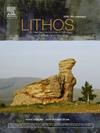Petrogenesis and high-precision U-Pb zircon geochronology of the Howley Islands intrusions, Central Newfoundland Appalachians: Hydrous magmatism of Emsian age (ca. 400 Ma) along a multi-million-ounce orogenic gold belt
IF 2.5
2区 地球科学
Q2 GEOCHEMISTRY & GEOPHYSICS
引用次数: 0
Abstract
The Howley Islands intrusions consist of three coarse-grained amphibole-phlogopite/biotite quartz gabbro dykes and one medium-grained amphibole-biotite quartz diorite body that cut rocks of the Exploits Subzone in central Newfoundland along strike from the multi-million-ounce Valentine gold deposits. The petrogeneses and ages of these rocks were investigated to better constrain the process evolution of the orogenic gold belt that extends for more than 200 km across central Newfoundland.
The quartz gabbro dykes are composed of magnesio-ferri-hornblende-cummingtonite-phlogopite/biotite macrocrysts mantled by plagioclase (labradorite to oligoclase)-quartz coronas. The gabbros are LILE- and LREE-enriched, transitional arc-like rocks that formed from a different melt source and parental magma than the quartz diorite body. The quartz diorite is plagioclase-rich (50 modal % andesine), contains only trace cummingtonite, lacks phlogopite, and preserves rare diopside overgrown by magnesio-ferri-hornblende. This intrusion is more alkaline and OIB-like than the quartz gabbros and exhibits the influence of a deeper, more enriched mantle component, although both melts variably interacted with deep lithosphere. The quartz gabbro dykes and quartz diorite body may represent melts of the lower lithosphere and upper asthenosphere, respectively.
The abundance of coarse- to medium-grained amphibole and phlogopite/biotite in the samples is consistent with crystallization of hydrous magmas and rapid, water-enhanced crystal growth, with cooling paths recorded by chemically zoned grains of magnesio-ferri-hornblende and plagioclase. One quartz gabbro displays reverse core to rim chemical zoning of plagioclase from andesine to labradorite, which may reflect decreasing pressure during magma ascent and crystallization, magma mixing of evolved and more primitive magmas, and/or fluctuations in H2O content. The presence of cummingtonite suggests crystallization at relatively low temperatures in shallow, low-pressure, upper crustal magma chambers. The quartz gabbros may represent melts equivalent to the nearby Howley Islands gabbro body, whereas the quartz diorite may represent a plagioclase cumulate along the margin of another melt chamber.
U-Pb CA-ID-TIMS zircon geochronology yielded ages of ca. 400.3 Ma for the gabbro dykes and 399.9 Ma for the quartz diorite intrusion, within the ca. 410–377 Ma age range for mineralization of the nearby Valentine gold deposits. The ca. 400 Ma intrusions, when considered in conjunction with regional models, reflect melting and hydrous magmatism in the mantle wedge above a retreating Avalonian slab that was dehydrating during the Acadian orogenic cycle. The coincidence of Pridoli (ca. 422 Ma) to Emsian (ca. 400 Ma) bimodal magmatism and orogenic gold mineralization in central Newfoundland reflects more than twenty million years of high geothermal gradients and fluid flow, which when combined with structural focusing along faults, was apparently optimal for the formation of orogenic gold deposits of significant economic potential.
纽芬兰阿巴拉契亚山脉中部豪利群岛侵入体的岩石成因和高精度 U-Pb 锆石地质年代学:沿数百万盎司造山金矿带的艾姆西亚时代(约 400 Ma)水成岩作用
豪利群岛的侵入体包括三个粗粒闪长岩-闪长岩/闪长岩石英辉长岩岩体和一个中粒闪长岩-闪长岩石英闪长岩岩体,它们沿着数百万盎司的瓦伦丁金矿床的走向切割纽芬兰中部Exploits子区的岩石。对这些岩石的岩石成因和年龄进行了研究,以更好地确定在纽芬兰中部延伸 200 多公里的造山型金矿带的过程演化。石英辉长岩岩堤由镁铁角闪长玢岩-辉长岩-透辉石/闪长岩大斜长岩组成,斜长岩(拉长斜长岩至寡长斜长岩)-石英冠岩覆盖着这些大斜长岩。辉长岩是富含 LILE 和 LREE 的过渡性弧状岩石,由不同于石英闪长岩体的熔融源和母岩形成。石英闪长岩富含斜长石(安山岩的模数百分比为 50%),只含有微量的积云母,缺乏辉绿岩,并保留了被镁铁角闪石覆盖的稀有透辉石。与石英辉长岩相比,这种侵入体的碱性更强,更类似于 OIB,并受到更深、更富集的地幔成分的影响,尽管这两种熔体都与深岩石圈有不同程度的相互作用。石英辉长岩堤和石英闪长岩体可能分别代表下岩石圈和上星体层的熔体。样品中大量的粗粒至中粒闪长岩和辉绿岩/闪长岩与含水岩浆的结晶和快速的水强化晶体生长相一致,冷却路径由镁铁角闪石和斜长石的化学分带颗粒记录。其中一块石英辉长岩显示出从岩心到岩缘的斜长石从安山岩到拉长石的反向化学分带,这可能反映了岩浆上升和结晶过程中压力的降低、演化岩浆和更原始岩浆的混合,以及/或 H2O 含量的波动。积云母的存在表明,结晶是在浅层、低压、上地壳岩浆室中相对较低的温度下进行的。石英辉长岩可能代表相当于附近豪利群岛辉长岩体的熔体,而石英闪长岩可能代表另一个熔岩室边缘的斜长岩积聚体。U-Pb CA-ID-TIMS 锆石地质年代测定结果显示,辉长岩堤的年龄约为 400.3 Ma,石英闪长岩侵入体的年龄约为 399.9 Ma,均在约 410-377 Ma 的年龄范围内。附近瓦伦丁金矿床的成矿年龄在 410-377 Ma 之间。约 400 Ma 的侵入体如果结合区域模型考虑,400 Ma侵入体反映了阿卡迪亚造山运动周期中正在脱水的阿瓦隆板块上部地幔楔的熔融和含水岩浆活动。纽芬兰中部的普里多利(约 422 Ma)至埃姆西安(约 400 Ma)双峰岩浆活动与造山金矿的巧合反映了两千多万年的高地热梯度和流体流动,再加上沿断层的结构聚焦,显然是形成具有巨大经济潜力的造山金矿的最佳条件。
本文章由计算机程序翻译,如有差异,请以英文原文为准。
求助全文
约1分钟内获得全文
求助全文
来源期刊

Lithos
地学-地球化学与地球物理
CiteScore
6.80
自引率
11.40%
发文量
286
审稿时长
3.5 months
期刊介绍:
Lithos publishes original research papers on the petrology, geochemistry and petrogenesis of igneous and metamorphic rocks. Papers on mineralogy/mineral physics related to petrology and petrogenetic problems are also welcomed.
 求助内容:
求助内容: 应助结果提醒方式:
应助结果提醒方式:


